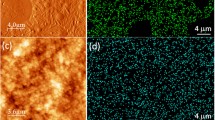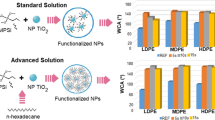Abstract
Polypropylene (PP) surfaces with reversible switching between superhydrophobicity and superhydrophilicity were fabricated by a simple dip-coating method. The reversibility was obtained using a combination of UV and thermal treatment cycles. Superhydrophobic polymeric surfaces were prepared by dipping PP substrates in a hot suspension of xylene containing TiO2 nanoparticles (NPs) functionalized with trimethoxypropyl silane (TMPSi). This resulted in superhydrophobic PP surfaces with water contact angles (WCA) of 158° that were converted to superhydrophilic (WCA ~0°) by UV irradiation. However, the superhydrophobic state can be easily recovered using a soft thermal treatment (100 °C for 2 h). A continuous switch in the extreme wettability properties of the surfaces was achieved using cycles of UV irradiation and thermal treatments. Additionally, the hydrophilicity obtained by UV illumination improved the weak adhesion that existed between the nanocoating and the PP surface before the UV treatment by about 90 %. Detailed high-resolution X-ray photoelectron spectroscopy data showed that the relative concentration of the hydrophilic component, Ti–OH, in the O 1s signal increased from 32 % to more than 50 % when the surface was irradiated. Simultaneously, the Ti 2p signal showed a reduction of Ti(IV) to Ti(III) after the photochemical treatment leading to a surface hydroxylation and the superhydrophilicity found after UV irradiation. This paper reports the preparation of PP surfaces with excellent controllable wettability with important applications where improvement in the coating adhesion is necessary.







Similar content being viewed by others
References
Zach M, Hagglund C, Chakarov D, Kasemo B (2006) Nanoscience and nanotechnology for advanced energy systems. Curr Opin Solid State Mater Sci 10(3–4):132–143
Paul DR, Robeson LM (2008) Polymer nanotechnology: nanocomposites. Polymer 49(15):3187–3204
Rehim MHA, Youssef AM, Ghanem A (2015) Polystyrene/hydrophobic TiO2 nanobelts as a novel packaging material. Polym Bull 72(9):2353–2362
Behniafar H, Amirkhalili SK (2014) Poly(4,4′-oxydiphenylene-pyromellitimide)/TiO2 nanocomposites with surface-modified titanium dioxide using 4,4′-methylene diphenyl diisocyanate. Polym Bull 71(4):775–785
Ferdowsi P, Mokhtari J (2015) Fabrication and characterization of electrospun PVA/CdS and PVA/TiO2 nanocomposite thin films as n-type semiconductors. Polym Bull 72(9):2363–2375
Zehetmeyer G, Scheibel JM, Soares RMD, Weibel DE, Oviedo MAS, Oliveira RVB (2013) Morphological, optical, and barrier properties of PP/MMT nanocomposites. Polym Bull 70(8):2181–2191
Celia E, Darmanin T, de Givenchy ET, Amigoni S, Guittard F (2013) Recent advances in designing superhydrophobic surfaces. J Colloid Interface Sci 402:1–18
Yan YY, Gao N, Barthlott W (2011) Mimicking natural superhydrophobic surfaces and grasping the wetting process: a review on recent progress in preparing superhydrophobic surfaces. Adv Colloid Interface Sci 169(2):80–105
Nishimoto S, Bhushan B (2013) Bioinspired self-cleaning surfaces with superhydrophobicity, superoleophobicity, and superhydrophilicity. RSC Adv 3(3):671–690
Neto AI, Meredith HJ, Jenkins CL, Wilker JJ, Mano JF (2013) Combining biomimetic principles from the lotus leaf and mussel adhesive: polystyrene films with superhydrophobic and adhesive layers. RSC Adv 3(24):9352–9356
Gao Z, Ma M, Zhai X, Zhang M, Zang D, Wang C (2015) Improvement of chemical stability and durability of superhydrophobic wood surface via a film of TiO2 coated CaCO3 micro-/nano-composite particles. RSC Adv 5(79):63978–63984
Wenzel RN (1936) Resistance of solid surfaces to wetting by water. Ind Eng Chem 28(1):988–994
Cassie ABD, Baxter S (1944) Wettability of porous surfaces. Trans Faraday Soc 40:546–551
Chagas GR, Darmanin T, Guittard F (2015) Nanostructured superhydrophobic films synthesized by electrodeposition of fluorinated polyindoles. Beilstein J Nanotechnol 6:2078–2087
Marmur A (2004) The lotus effect: superhydrophobicity and metastability. Langmuir 20(9):3517–3519
Marmur A (2008) From hygrophilic to superhygrophobic: theoretical conditions for making high-contact-angle surfaces from low-contact-angle materials. Langmuir 24(14):7573–7579
Marmur A (2013) Superhydrophobic and superhygrophobic surfaces: from understanding non-wettability to design considerations. Soft Matter 9(33):7900–7904
Yue M, Zhou B, Jiao K, Qian X, Xu Z, Teng K, Zhao L, Wang J, Jiao Y (2015) Switchable hydrophobic/hydrophilic surface of electrospun poly (l-lactide) membranes obtained by CF4 microwave plasma treatment. Appl Surf Sci 327:93–99
Feng N, Zhao H, Zhan J, Tian D, Li H (2012) Switchable wettability sensor for ion pairs based on calix[4]azacrown clicking. Org Lett 14(8):1958–1961
Abate AR, Thiele J, Weinhart M, Weitz DA (2010) Patterning microfluidic device wettability using flow confinement. Lab Chip 10(14):1774–1776
Wu J, Jiang Y, Jiang D, He J, Cai G, Wang J (2015) The fabrication of pH-responsive polymeric layer with switchable surface wettability on cotton fabric for oil/water separation. Mater Lett 160:384–387
Xiong S, Kong L, Huang J, Chen X, Wang Y (2015) Atomic-layer-deposition-enabled nonwoven membranes with hierarchical ZnO nanostructures for switchable water/oil separations. J Membr Sci 493:478–485
Li JS, Ueda E, Nallapaneni A, Li LX, Levkin PA (2012) Printable superhydrophilic-superhydrophobic micropatterns based on supported lipid layers. Langmuir 28(22):8286–8291
Godeau G, Darmanin T, Guittard F (2015) Switchable and reversible superhydrophobic and oleophobic surfaces by redox response using covalent S-S bond. React Funct Polym 96:44–49
Chhatre SS, Tuteja A, Choi W, Revaux A, Smith D, Mabry JM, McKinley GH, Cohen RE (2009) Thermal annealing treatment to achieve switchable and reversible oleophobicity on fabrics. Langmuir 25(23):13625–13632
Taleb S, Darmanin T, Guittard F (2014) Elaboration of voltage and ion exchange stimuli-responsive conducting polymers with selective switchable liquid-repellency. ACS Appl Mater Interfaces 6(10):7953–7960
Darmanin T, Guittard F (2013) pH- and voltage-switchable superhydrophobic surfaces by electro-copolymerization of EDOT derivatives containing carboxylic acids and long alkyl chains. ChemPhysChem 14(11):2529–2533
Döbbelin M, Tena-Zaera R, Marcilla R, Iturri J, Moya S, Pomposo JA, Mecerreyes D (2009) Multiresponsive PEDOT–ionic liquid materials for the design of surfaces with switchable wettability. Adv Funct Mater 19(20):3326–3333
Cheng Z, Lai H, Du Y, Fu K, Hou R, Li C, Zhang N, Sun K (2014) pH-induced reversible wetting transition between the underwater superoleophilicity and superoleophobicity. ACS Appl Mater Interfaces 6(1):636–641
Xu L, Chen W, Mulchandani A, Yan Y (2005) Reversible conversion of conducting polymer films from superhydrophobic to superhydrophilic. Angew Chem Int Ed 44(37):6009–6012
Huang Y, Hu M, Yi S, Liu X, Li H, Huang C, Luo Y, Li Y (2012) Preparation and characterization of silica/fluorinated acrylate copolymers hybrid films and the investigation of their icephobicity. Thin Solid Films 520(17):5644–5651
Wagner N, Theato P (2014) Light-induced wettability changes on polymer surfaces. Polymer 55(16):3436–3453
Soroushnia S, Bastani S, Mohseni Bozorgi M, Rostami M (2015) Surface properties and surface patterning of UV-curable coating using perfluorosilane-treated nanosilica. Prog Org Coat 85:31–37
Chiavari C, Balbo A, Bernardi E, Martini C, Zanotto F, Vassura I, Bignozzi MC, Monticelli C (2015) Organosilane coatings applied on bronze: influence of UV radiation and thermal cycles on the protectiveness. Prog Org Coat 82:91–100
Hou W, Wang Q (2009) UV-driven reversible switching of a polystyrene/titania nanocomposite coating between superhydrophobicity and superhydrophilicity. Langmuir 25(12):6875–6879
Li W, Guo T, Meng T, Huang Y, Li X, Yan W, Wang S, Li X (2013) Enhanced reversible wettability conversion of micro-nano hierarchical TiO2/SiO2 composite films under UV irradiation. Appl Surf Sci 283:12–18
Weibel DE (2011). Polymer assisted surface modification by photons. Nova Science Publishers, Inc., New York
Awaja F, Gilbert M, Kelly G, Fox B, Pigram PJ (2009) Adhesion of polymers. Prog Polym Sci 34(9):948–968
Peyvandi A, Abideen SU, Huang Y, Lee I, Soroushian P, Lu J (2014) Surface treatment of polymer microfibrillar structures for improved surface wettability and adhesion. Appl Surf Sci 289:586–591
Contreras CB, Chagas G, Strumia MC, Weibel DE (2014) Permanent superhydrophobic polypropylene nanocomposite coatings by a simple one-step dipping process. Appl Surf Sci 307:234–240
Ramanathan R, Weibel DE (2012) Novel liquid–solid adhesion superhydrophobic surface fabricated using titanium dioxide and trimethoxypropyl silane. Appl Surf Sci 258(20):7950–7955
Chagas GR, Weibel DE (2014) Development of poly(propylene) superhydrophobic surfaces by functionalised TiO2 nanoparticles: effect of solvents and dipping times. Macromol Symp 344(1):55–62
Feng X, Zhai J, Jiang L (2005) The fabrication and switchable superhydrophobicity of TiO2 nanorod films. Angew Chem Int Ed 44(32):5115–5118
Miyauchi M, Kieda N, Hishita S, Mitsuhashi T, Nakajima A, Watanabe T, Hashimoto K (2002) Reversible wettability control of TiO2 surface by light irradiation. Surf Sci 511(1–3):401–407
Wardle B (2009) Principles and applications of photochemistry. Wiley, Manchester
Shultz AN, Jang W, Hetherington Iii WM, Baer DR, Wang L-Q, Engelhard MH (1995) Comparative second harmonic generation and X-ray photoelectron spectroscopy studies of the UV creation and O2 healing of Ti3+ defects on (110) rutile TiO2 surfaces. Surf Sci 339(1–2):114–124
Wang L-Q, Baer DR, Engelhard MH, Shultz AN (1995) The adsorption of liquid and vapor water on TiO2(110) surfaces: the role of defects. Surf Sci 344(3):237–250
Moulder JF, Chastain J (1992) Handbook of X-ray photoelectron spectroscopy: a reference book of standard spectra for identification and interpretation of XPS data. Physical Electronics Division, Perkin-Elmer Corporation
Yu J, Zhao X, Zhao Q (2001) Photocatalytic activity of nanometer TiO2 thin films prepared by the sol–gel method. Mater Chem Phys 69(1–3):25–29
Guillot J, Fabreguette F, Imhoff L, Heintz O, Marco de Lucas MC, Sacilotti M, Domenichini B, Bourgeois S (2001) Amorphous TiO2 in LP-OMCVD TiNxOy thin films revealed by XPS. Appl Surf Sci 177(4):268–272
Zhang F, Jin S, Mao Y, Zheng Z, Chen Y, Liu X (1997) Surface characterization of titanium oxide films synthesized by ion beam enhanced deposition. Thin Solid Films 310(1–2):29–33
Zhao X-T, Sakka K, Kihara N, Takata Y, Arita M, Masuda M (2006) Hydrophilicity of TiO2 thin films obtained by RF magnetron sputtering deposition. Curr Appl Phys 6(5):931–933
Wang X-P, Yu Y, Hu X-F, Gao L (2000) Hydrophilicity of TiO2 films prepared by liquid phase deposition. Thin Solid Films 371(1–2):148–152
Sanjinés R, Tang H, Berger H, Gozzo F, Margaritondo G, Lévy F (1994) Electronic structure of anatase TiO2 oxide. J Appl Phys 75(6):2945–2951
Joo S, Baldwin DF (2010) Adhesion mechanisms of nanoparticle silver to substrate materials: identification. Nanotechnology 21(5):1–12
Acknowledgments
This work was partially supported by the Conselho Nacional de Desenvolvimento Científico e Tecnoloǵico (CNPq) (Processes No. 550461/2012-4 and 477200/2012-5) and LNLS-National Synchrotron Light Laboratory, Brazil. The authors would also like to acknowledge the technical assistance of the Accelerator Group, especially the VUV and Soft X-ray Spectroscopy Group. G.R. Chagas thanks CAPES for the fellowship awarded. The authors thank Centro de Nanociência e Nanotecnologia (CNANO), UFRGS, for the SEM analysis. We also thank Alessandra F. Baldissera and Prof. Carlos A. Ferreira from Polymeric Materials Laboratory (LaPol), UFRGS for the assistance on adhesion measures.
Author information
Authors and Affiliations
Corresponding author
Electronic supplementary material
Below is the link to the electronic supplementary material.
Rights and permissions
About this article
Cite this article
Chagas, G.R., Weibel, D.E. UV-induced switchable wettability between superhydrophobic and superhydrophilic polypropylene surfaces with an improvement of adhesion properties. Polym. Bull. 74, 1965–1978 (2017). https://doi.org/10.1007/s00289-016-1817-x
Received:
Revised:
Accepted:
Published:
Issue Date:
DOI: https://doi.org/10.1007/s00289-016-1817-x




